How to Buy the Best TV Antenna
Key pointers of what to look for when buying a TV antenna: inside outside, antenna type, gain, how big.
Home » Antennas & Propagation » this page
TV antennas guides include:
Types of TV antenna
Buying a TV antenna
TV antenna direction alignment & pointing
TV transmitter finder app
TV antenna alignment meter
Buying TV antenna amplifier / booster
Indoor TV antenna & set-up
Satellite TV dish installation
How to wire a TV antenna socket
Why doesn't a TV antenna work any more
General antenna installation guides
Antenna installation guide
Attic installation
Antenna height
Selecting the right TV antenna for your particular television and location requires a number of things to be considered.
The type of antenna - is it to be used for satellite or terrestrial, along with decisions about an internal or external antenna, antenna gain, format and many other things.
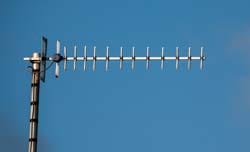
When selecting an antenna there is a huge variety of antennas from which to make a selection.
It is also worth remembering that television tranmissions and techniques vary from one country to the next. As a result, TV antenna types and technology vary from one country to the next. As a result, it is necessary to look at the requirements in light of the country in which the antenna is being used.
Satellite or terrestrial
The first decision to be made is whether the antenna is to be used for terrestrial or satellite (DBS) broadcasts.
Satellite antennas typically require the use of a parabolic reflector or dish antenna. These need to be accurately aligned on the antenna and receive signals from the satellite, often at frequencies typically between 10.95 and 12.75GHz.
Terrestrial transmissions typically operate on frequencies in the UHF portion of the radio spectrum, although there are still some operating in the VHF portion of the spectrum in some countries.
A variety of antennas can be used from external antennas on rooftops to internal ones that may take one of a variety of forms.
It is essential that a specific satellite antenna is used for satellite transmissions and a terrestrial antenna for terrestrial TV transmissions.
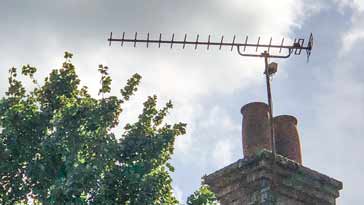
Indoor / outdoor
One major consideration to think about when buying a TV antenna is whether the antenna should be internal or external.
Internal antennas typically do not perform as well - the walls of the building reduce the signal and there are also reflections caused by objects on the building.
Interference levels are also higher from fluorescent lights, electrical equipment and many other items. External antennas are able to pick up a much better signal, but they cost more to erect and the cables are longer.
If you live in a high signal area then an internal antenna may work well for you, but if the signal is not too strong, then an external antenna will always be better.
Internal TV antennas might be a simple set top antenna. These antennas tend to be relatively smal and by their very nature they do not have much gain, although some have an internal pre-amplifier to make up for the lower strength signals that are received. However the amplifier can fully never make up for the low strength os the signals received and noise levels tend to be higher.
However for people living near a transmitter they may work well.
It is also possible to use a much higher gain antenna in the roof space or attic. These have a beter chance of working well, but again, the roof itself and other objects may obscure the transmitter and reduce the signal levels.
Frequency coverage
When buying a TV antenna, the frequency coverage is a key point to note. In countries where there is VHF TV then a VHF antenna will be required. However most TV is broadcast on UHF, although in some countries, VHF is still used, and the antenna will need to be able to accommodate all the bands required.
Even when UHF is used, there are many bands and frequencies that are used, so be aware that the right TV antenna for your area will be needed.
Sometimes antennas will be sold as “Digital Antennas”. This refers more to the section of the TV band used rather than receiving analogue or digital transmissions.
Be aware that in some countries, different areas of the country may use TV channels in different sections of the band. In many countries they are grouped together so that the antenna bandwidth of the antenna can accomodate the various stations. But check on the Internet or with your local dealer to find out whether antennas need to be bought to match your particular area.
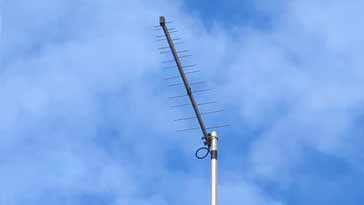
In situations where the frequencies of the transmitting are widely spaced, then a wideband antenna will be needed. The type of antenna which gives a wideband capability, along with directivity and gain is a log periodice antenna.
Although log periodic antennas do not give as much gain and directivity as a similar sized Yagi, they do provide sufficient gain for many situations.
Gain / directivity
One of the key parameters of any antenna is its gain. This is the increase in what may be termed its sensitivity in a particular direction. The higher the gain, the greater its ability to pick up weak signals.
When the gain is increased the antenna also becomes more directive, meaning that it must be more accurately directed towards the TV transmitter, but also this has the effect of reducing the level of interference that might be received from other directions.
The gain is specified in dB, or decibels. The higher the number of decibels the higher the gain. It should be noted that decibels are based on logarithms and therefore 10dB is an increase in gain of 10 fold, and 20dB is an increase in gain of 100 fold.
As decibels are only a ratio, it means that the ratio must compare the gain of the TV antenna to a standard. Two may be used. The first is a dipole and the second is what is termed an isotropic source - this is one that radiates equally well in all directions.
As the dipole itself has some gain, 2.1 dB over an isotropic source, it is necessary to know what the TV antenna gain is compared to. 10dB gain when referred to a dipole is the same as 12 dB when referred to an isotropic source . . so beware when comparing different antennas that the gain is referenced to the same type of reference antenna.
Antenna type or style
There are very many different styles of antenna used for terrestrial TV. The most popular form is the Yagi or Yagi-Uda, but many other types are available. Parabolic reflectors for satellite television; log periodic antennas where the television stations may be widely spaced in frequency and a wide bandwidth is required, etc . . The log periodic should be considered when TV reception is needed for a wide range of frequencies, but it will offer a lower gain than other types.
The main thing is to look at the size and the gain. If it is physically too large then it may be more difficult to mount. It will also be more susceptible to damage from the wind, and more robust fixing arrangements will be needed and this will cost more.
Mechanical robustness
With externally mounted television antennas needing to withstand the rigours of the weather, any antenna that might be chosen should be robust.
It is sometimes interesting to walk around the locality and see which types of antennas remain intact, and which types start to fall apart.
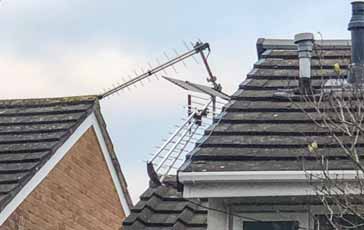
Some designs may be more prone to failure than others, so it is worth checking to see which ones seem to survive best.
TV amplifier
In some areas a TV antenna amplifier may be needed to boost the signal. There are many different types of TV antenna booster amplifiers that are available.
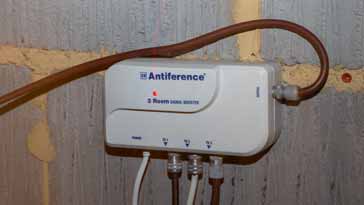
Some of the TV antenna amplifiers provide a splitter function, enabling a single antenna to feed more than one television.
Also when using a TV antenna amplifier, there are a few points to note before installing one. It is best to do a little research before going ahead with one, especially if it is an external one that will cost more to buy and install.
These are some of the main features of TV antennas. Buying an antenna is normally a relatively straightforward process and they can be bought from the Internet or a local dealer. Make sure that when an antenna is bought that good quality cable is used - old cable, especially if it has been used outside can have moisture in it and this will increase the level of loss it introduces - it is always best to use new cable with a new antenna, and seal the external end to prevent moisture getting inside it.
 Written by Ian Poole .
Written by Ian Poole .
Experienced electronics engineer and author.
More Antenna & Propagation Topics:
EM waves
Radio propagation
Ionospheric propagation
Ground wave
Meteor scatter
Tropospheric propagation
Antenna basics
Cubical quad
Dipole
Discone
Ferrite rod
Log periodic antenna
Parabolic reflector antenna
Phased array antennas
Vertical antennas
Yagi
Antenna grounding
Installation guidelines
TV antennas
Coax cable
Waveguide
VSWR
Antenna baluns
MIMO
Return to Antennas & Propagation menu . . .



